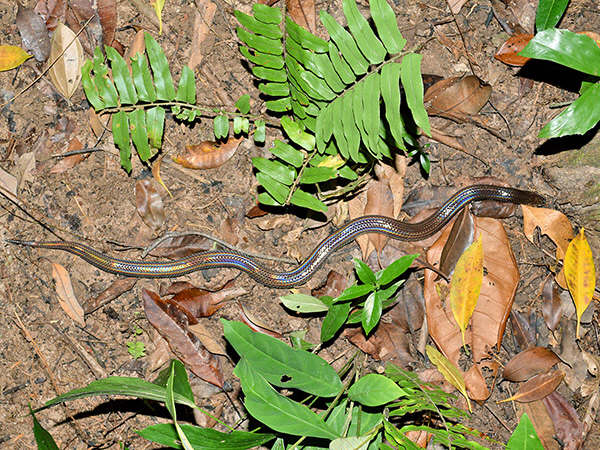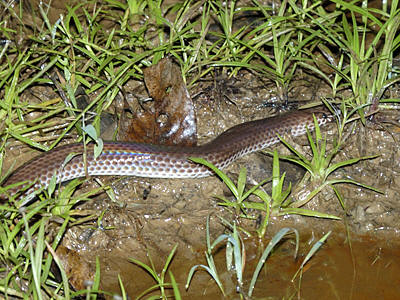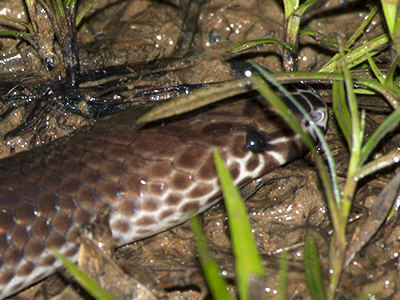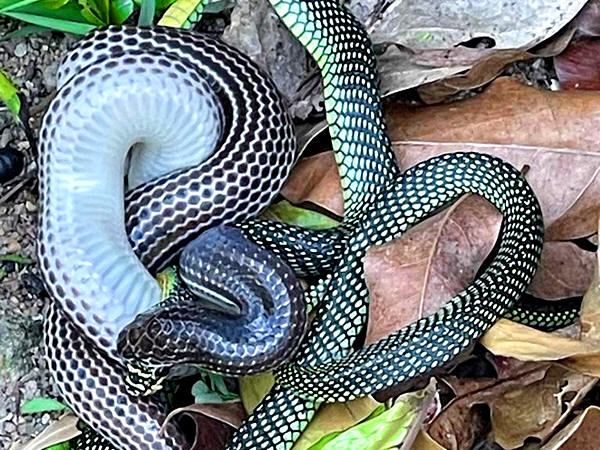
Fig 1

Fig 2

Fig 3
 |
Family : XENOPELTIDAE
Species : Xenopeltis unicolor
Maximum Size : 1.2 metres
Xenopeltis unicolor
(Sunbeam Snake or
Iridescent Earth Snake) is one of just two species in the family
Xenopeltidae, the other being the Hainan Sunbeam Snake.
This snake is fully terrestrial and inhabits lowland to lower montane
forest, scrubland and disturbed habitats. On a local scale, it seems to
prefer wet, boggy or swampy ground where it follows a partly burrowing
lifestyle.
Sunbeam snakes are so-called because of their smooth scales which, under
strong light such as sunlight or camera flash, are highly iridescent.
Under normal light this snake is typically brown above, with each scale being
pale-edged, and pale below. Juveniles are more dark, and have a pale collar
across the back of the neck.
Xenopeltis unicolor has a relatively robust body, and a flattened
head which is no wider than the body. Its snout is rounded, and its eyes are
small. Its tail is short.
It typically preys on a variety of small vertebrates including frogs and lizards.
In Singapore, it has been recorded preying on other snakes, including a
Paradise Tree Snake which had ventured
to the forest floor (see Fig 4).
In terms of evolution, sunbeam snakes are considered to be an ancient,
'basal', form of snake more closely related to pythons and boas than more
modern groups of snakes.
The Sunbeam Snake is wide-ranging, and occurs in Myanmar, Thailand, Indochina
(Laos, Cambodia, Vietnam), Peninsular Malaysia, Singapore, Sumatra, Borneo,
Java and many other smaller islands of Indonesia, and the Philippines.
Outside the region it occurs in parts of southern China and the Nicobar
Islands (India).
Fig 1 : Example from lowland secondary forest in southern Singapore.
Figs 2 and 3 : Sunbeam Snake in waterlogged, muddy habitat near freshwater
swamp forest, Singapore.
Fig 4 : Example from Sentosa Island, Singapore, attempting to prey on a
Paradise Tree Snake Chrysopelea
paradisi. The latter is a predominantly arboreal snake, and would have
fallen victim to the sunbeam snake when it ventured to the forest floor.
Photo thanks to Allan Toner.
Fig 5 : Fully grown specimen swimming across a shallow, rural pond,
Singapore.
Fig 6 : Juvenile in coastal forest on the island of
Phuket, Thailand.
Fig 7 : Juvenile from Siem Reap, Cambodia. Photo thanks to Derek Clark.
Fig 8 : Under dull light the scales lack iridescence.
Fig 9 : Under strong light the scales are highly iridescent.
References :
Das, I., 2010. A Field Guide to the Reptiles of South-east Asia. New Holland
Publishers (UK) Ltd.
|